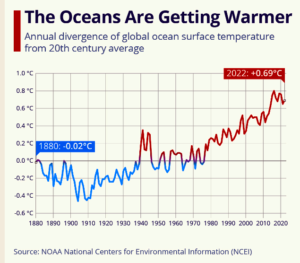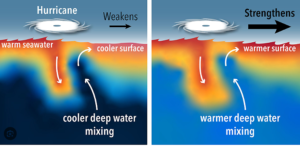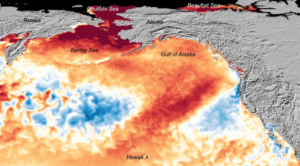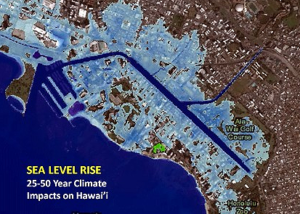Hawaii’s Ocean is Hot, and Getting Hotter
All in all, 2023 was Earth’s hottest year in over 150 years. Surrounded by Ocean, Hawaii’s climate clock is running down to zero hour faster than many realize. As it was with ancient Hawaiians, Hawaii today is fully dependent upon and linked to the ocean which surrounds it.
 For the past year, oceans around the world have been substantially warmer than usual. January 2024 was the hottest month on record in the world’s oceans, and temperatures have continued to rise since then.
For the past year, oceans around the world have been substantially warmer than usual. January 2024 was the hottest month on record in the world’s oceans, and temperatures have continued to rise since then.
The New York Times described the new climate findings earlier this week in very stark terms with a headline that read; “Scientists Are Freaking Out About Ocean Temperatures”.
For the past year, oceans around the world have been substantially warmer than usual. Last month was the hottest January on record in the world’s oceans, and temperatures have continued to rise since then. Each new year now is producing new global heating records.
New data from a variety of sources has led climate scientists to suggest that global warming is accelerating.
University of Miami, Brian McNoldy, an expert in hurricane formation, has been tracking the latest temperature data from the North Atlantic with a mixture of concern and bewilderment. McNoldy sums things up this way …“The North Atlantic has been record-breaking warm for a year now,”, “it’s just astonishing. It’s quite scary, partly because I’m not hearing any scientists that have a convincing explanation of why it is we’ve got such a departure. We’re used to having a fairly good handle on things. But the impression at the moment is that global heating has gone further and faster than we expected.”
Over the past year, worldwide average temperatures were more than 1.5 degrees Celsius, or 2.7 degrees Fahrenheit, higher than before the industrial age, and sea temperatures have kept on climbing in February, surpassing the daily records set last August.
The principal driver of all this warmth is no mystery to scientists: The burning of fossil fuels, global deforestation, and other human activities are driving temperatures steadily upward. The current El Niño weather cycle is also allowing more ocean heat to be released into the atmosphere.
More than 680 million people, nearly 10 percent of the global population, live in low-lying coastal zones. Bearing the brunt of climate-driven ocean extremes, some highly vulnerable communities in low-lying areas, including small Pacific island chains, are 15 times more likely to be killed by floods and storms, compared to other regions with lower climate vulnerability.
A well-established link between rising ocean temperatures and an increasing imbalance between healthy marine environments is also well understood.
The ocean further generates 50 percent of the oxygen we need, absorbs 25 percent of all carbon dioxide emissions, and captures 90 percent of the excess heat generated by these emissions. It is not just ‘the lungs of the planet’ but also its largest ‘carbon sink’ – a vital buffer against the impacts of climate change.
The ocean is also central to reducing global greenhouse gas emissions and stabilizing the Earth’s climate. However, increasing greenhouse gas emissions have affected the health of the ocean – warming and acidifying seawater – causing detrimental changes to life underwater and on land, and reducing the ocean’s ability to absorb carbon dioxide and safeguard life on the planet.
Warmer oceans provide more fuel for hurricanes and atmospheric river storms and can disrupt marine life, and life on land. Hawaii’s policymakers and residents who ignore what’s happening around them and delay or procrastinate meaningful transition measures which prepare Hawaii for the new climate reality now underway, do so at their and everyone else’s peril.
The Climate Outlook for Hawaii and the Mid-Pacific
New data from a variety of sources has led some climate scientists to suggest that global warming is accelerating. It was the hottest January on record for the oceans, too, according to the European Union’s Copernicus Climate Change Service.

The intensity of recent underwater heat waves prompted the National Oceanic and Atmospheric Administration in December to add three new levels to its system of ocean heat alerts to indicate where corals might be bleaching or dying.
It is already well established that Hawaii’s globally remote mid-Pacific location does not exempt the state from macro changes in climate, rising temperatures, and extreme weather events no underway. Changes in climate are further impacting Hawaii’s historic seasonal weather and temperature patterns, producing increasing extreme weather events, as the painful consequences of the recent Lahaina extreme wind storm and fire tragedy demonstrated to all of Hawaii’s residents.
For island states like Hawaii, sea level rise is inescapable. The global impacts of warming are compounded by El Niño events in the equatorial Pacific, increasingly fueling elevated sea surface temperatures and the corresponding consequences.
Ocean temperatures in the mid-Pacific have been rising steadily and significantly over the past 50 years, consistently rising, with an average rise of 0.14°F per decade from 1901 through 2020. Recent data shows that overall ocean temperatures have surpassed 70° Fahrenheit, reaching uncharted territory for modern records.
The rapid acceleration of ocean temperatures has now led scientists to express serious concerns about the uncharted territory we are entering due to unprecedented levels of warming in oceans and air temperatures.
For Hawaii, rising ocean temperatures are already having profound impacts on:
- Marine ecosystems
- accelerated coral bleaching,
- changes in biodiversity, and
- disruptions to weather patterns, locally and globally, and
- agricultural impacts.
An El Niño pattern like the one currently observed in the Pacific is associated with warmer years for the planet, as well as a swath of effects on rainfall and temperatures in specific regions.
 But as humans heat the planet, the effects that forecasters could once confidently expect El Niño to have on local temperatures are no longer predictable, said Michelle L’Heureux, a NOAA scientist who studies El Niño and its opposite phase, La Niña.
But as humans heat the planet, the effects that forecasters could once confidently expect El Niño to have on local temperatures are no longer predictable, said Michelle L’Heureux, a NOAA scientist who studies El Niño and its opposite phase, La Niña.
As rising temperatures drive rising sea levels, Hawaii and other island states find themselves on the front lines of changes now demanding a sea-change of climate adaptation measures in the form of local mitigation measures; environmental, structural, and social.
The Effects of Sea Level Rise in Hawaii
Sea level rise in Hawaii is primarily attributed to global warming and the resulting melting of ice caps, leading to the expansion of seawater and the inundation of coastal areas. The rise in sea level around Hawaii is accelerated by factors such as melting ice caps, increasing air and sea surface temperatures, an overall decline in rainfall, and decreased stream base flows.
The impacts of rising sea levels in Hawaii are already being felt and are projected to worsen significantly in the coming years, Hawaii can expect:
- Coastal Flooding: Increased frequency and reach of coastal floods affecting communities.
- Coastal Erosion: Loss of beaches with 13 miles already eroded, threatening 70% of beaches statewide.
- Inland Flooding: More frequent flooding further inland, affecting communities not just near the coast.
- High Tide Flooding: More frequent high tide flooding threatening cities, damaging infrastructure, roads, and overwhelming drainage systems.
- Cultural Impact: Affecting traditional practices like fishpond maintenance, salt cultivation, and nearshore fisheries gathering.
 A 2050 forecast of rising sea levels, increasing droughts, and hot ocean temperatures in the waters surrounding Hawaii all point to a state presently unprepared for the growing threat to the state’s sustainability, economic viability, and livability.
A 2050 forecast of rising sea levels, increasing droughts, and hot ocean temperatures in the waters surrounding Hawaii all point to a state presently unprepared for the growing threat to the state’s sustainability, economic viability, and livability.
In the last decade, the speed at which Hawaii’s sea level is rising has increased — rising by as much as 1 inch every 3 years. Around Hilo Bay, it took 17 years for the sea level to rise 6 inches. Scientists now forecast the same increase in sea level rise will occur in less than the next 12 years.
By the end of the century, Honolulu could experience a sea level rise between 1.3 feet and 5.8 feet, and depending rising and accumulated carbon emissions. Events may be moving faster than science as forward looking sea-level estimates are increasingly being challenged as “too conservative”. Only recently has science begun to fully understand and factor new data elements such as recently quantifiable and accelerating meltdown of antarctic glaciers and ice caps. It is increasingly likely that Hawaii overall will see 3 feet or more of sea level rise by the end of this century, with higher levels plausible.
Building resilience into Hawaii’s economic, social, and environmental ecosystems requires more than just focusing on the state’s coastal communities. Hawaii is dependent upon a healthy and predictable ocean. That would include adaptation measures that predict risks, vulnerabilities, and solutions – including early warning systems and sustainable nature-based solutions to help communities cope with changing coastlines and failing ecosystems now under climate stress.
Publisher’s note to our readers
Continuing to live in the past is a social, economic, and cultural failure of state policy towards a meaningful climate threat response. This failure can be measured in varying degrees, but the indisputable conclusion is we are failing ourselves, our families, and placing added risks on the current and future generations of Hawaii’s residents – it is our carpe diem climate moment.




Leave a Reply
Join the Community discussion now - your email address will not be published, remains secure and confidential. Mahalo.